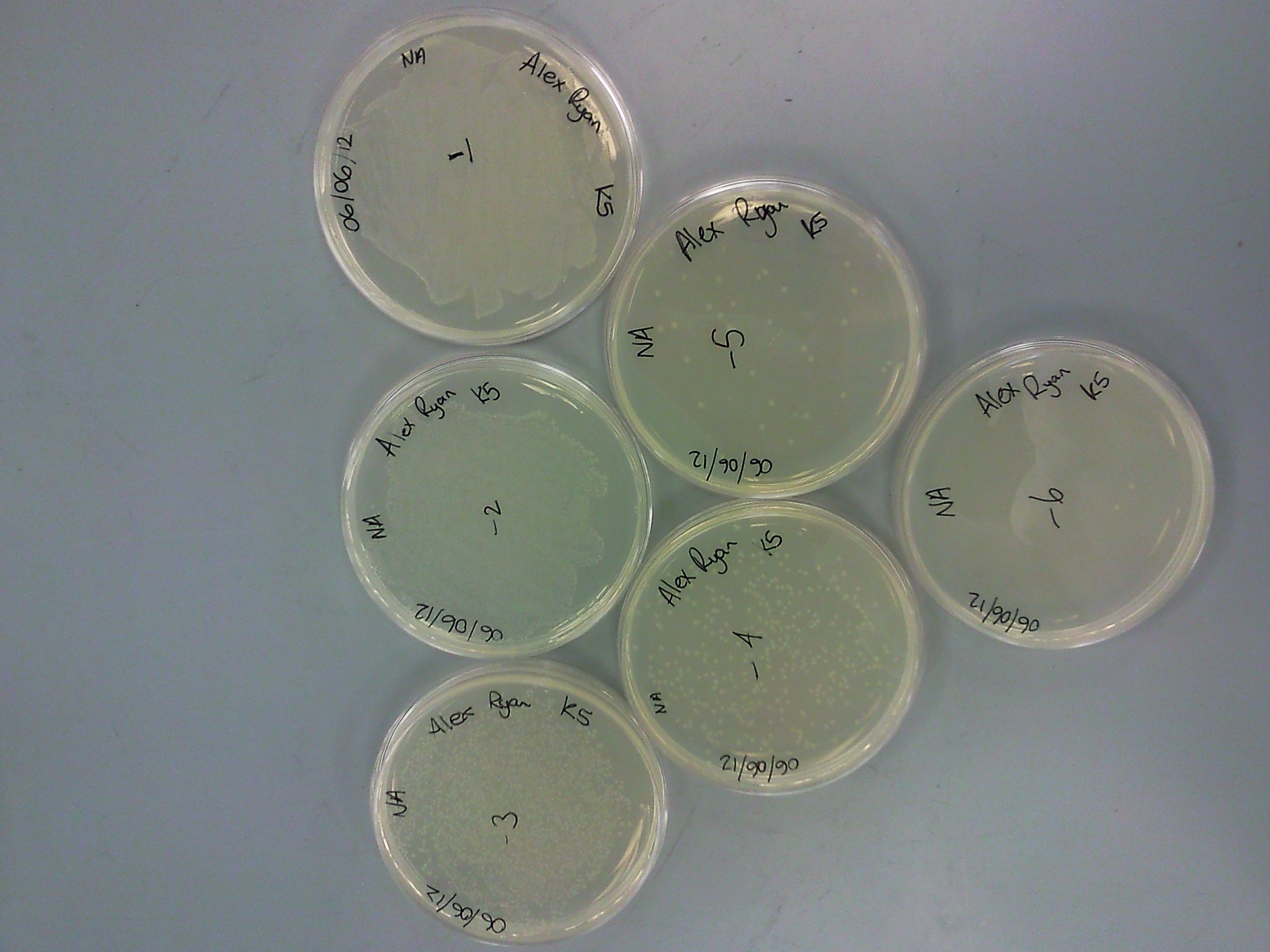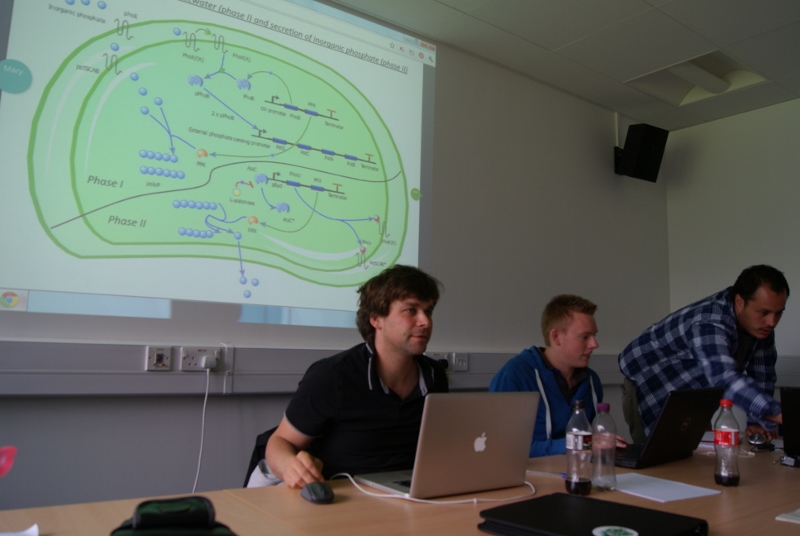Team:Exeter/Notebook
From 2012.igem.org
| Home | Team | Official Team Profile | Project | Parts Submitted to the Registry | Modeling | Notebook | Safety | Attributions |
|---|
The story so far...
The first three weeks of the project have been set aside to obtain a general biological background- particularly useful for the non-biologists in the team! This will be achieved through several short lectures, discussions and practical laboratory sessions. This allows every member of the team to have a suitable platform to create project designs. Ideas will be put forward and developed with the aim of making the final decision on Thursday 14th June. The subsequent ten weeks are set aside for the project to be developed.
WEEK ONE
28th May 2012
The team arrived and Tom (the project coordinator) started us off with an introduction to the iGEM competition, shortly followed by John Love giving a talk on synthetic biology. Tom got everyone up to scratch on basic biology (central dogma etc). Orkun Soyer (mathematician) gave a talk on biostability and then Christine Sambles gave an overview of the -omics.
29th May
Clive Butler talked about Thauera selenatis and microbial nano-material synthesis. Nick Smirnoff spoke on metabolic engineering and then Nic Harmer on polysaccharides. The afternoon session was set aside for brainstorming.
1st June
Today's lecturers:
- Tom- biofuel production.
- George Littlejohn- biosensors and reporters.
- Rob Beardmore (Biosciences)-dynamical systems modelling.
- Peter Petrov (Physics) - bacterial swimming and artificial swimmers.
The afternoon session was spent brainstorming, below are a selection of some of the ideas:
WEEK TWO
6th June
Initial lab induction with an in depth health and safety talk. Basic lab techniques were practiced, such as gel preparation and creating single colonies, see photograph insert for the very respectable results from a Physicist!
7th June
The second day of lab work- we isolated the DNA and then separated the DNA fragments using Gel Electrophoresis. The estimated sizes were then mapped and compared to expected maps.
8th June
Through many hours of brainstorming and discussion over the past two weeks the team has managed to single out a short-list of five strong ideas for the project which were presented to a range of relevant academics.
- Phosphate Collection- through synthetically modifying an organism the uptake of phosphates may be significantly increased.
- Polysaccharide synthesis - designer sugars. Creating a biological toolkit with which houses many material and medical applications.
- One-cell cellulose degradation - 'pac-man'. Find commonality for three types of cellulases and affix to scaffold. Could have transfer sequence to cell exterior.
- Logic-gated 'thinking' bacteria - improve on what has already been done somehow. Should work at level of proteins, not genes, for instant response.
- Biological ionising radiation detector- a method of detecting the strength of Gamma, X-ray and UV waves through their energy output.
After further discussion, two ideas were taken forward to next week...Polysaccharide synthesis and Phosphate Collection.
WEEK THREE
11th-15th June
Throughout the week we've all been super busy researching for the final presentation of our two ideas. We had to get our designs up to scratch for the scrutiny of a range of professors and researchers who really know their stuff! Freddy and Alice presented the two final ideas:
- Phosphantastic- Phosphate supplied are going to deplete within 30 years, and with 2/3rd of the world population relying directly upon Phosphate-based fertiliser... we feel it is a very important issue to tackle. The premise being through Synthetic modification we can create a two phase process where by the cell, in response to a promoter, uptakes way more Phosphate than would naturally occur. The second phase looks at excreting the phosphate ready for collection.
- Sweet Shop- A Polysaccharide catalogue which will eventually allow designer materials to be created, for example a polymer with strength x which yields at y. This idea, albeit a colossal challenge, if successful will change the outlook on Synthetic Biology and Materials Engineering.
Both ideas are especially strong and many of us changed our minds multiple times before the day was up. After a discussion weighing up the pros and cons of each design and its impact, we has an anonymous vote ....SWEET SHOP is our project for the summer! We're all super excited to get started....but before then, time for a relaxing game of pool!
WEEK FOUR
18th-22nd June
Project planning began at 9am Monday morning with a huge whiteboard and tonnes of enthusiasm. It's a tall order to try and organise a ten week project between ten students from different backgrounds, but we're working on it!
We all met with Professor Winlove in the giant Physics building to discuss how our Polysaccharide Synthesis could be used in the real world. He gave us lots of food for thought, as well as great views of Exeter.
A few people began developing their coding knowledge and started working on the wiki page. Through reading lots of books and trawling the web for tutorials their knowledge expanded! They also started using Adobe Illustrator and Photoshop to develop images for the website. It was amazing to see that within a few days so much could visually change for the project.
After meeting with a graphic designer and battling with potential new names and ideas we re-branded our project with the name, e-candi. After showing us several logo concepts we had plenty to consider as we called it a night and went away to design our own.
The next day our new name was discussed with the rest of our group and it was agreed that it sounded better than the original "Sweet Shop". In the evening we had a mini presentation, which later turned into a mini competition (showing off our designing abilities), displaying our different logo ideas developed from concepts put forward by our graphic designer Marian. The outright winner by the way was Alex ... sorry Ryan.
Press-relations were considered and an outreach program began with Alex B creating a Polysaccharide based dominoes game which we can use to not only teach school children about our idea but also inspire them to continue studying science!
A Café Scientifique session has been organised in September for us to discuss both our project and Synthetic Biology as a whole to a wider audience.
Taking care not to neglect the Biology - Alex B, Freddie, Becca and Mary managed to find a massive list of 120 Glycosyltransferases to add to the database.
The design of how the biological system will work was produced
"An Introduction to Systems Biology - Design Principles or Biological Circuits" by Uri Alon was read from cover to cover to help Liam with the modelling processes. The regulatory genetic network plasmid design was created through Tinkercell, with a view to have greater control over enzyme expression.
WEEK FIVE
25th-29th June
A meeting kicked off the week to find out where everyone is at within the project and to set targets for the week ahead. This helped us all to focus on the tasks in hand and to coordinate what everybody is doing.
The colossal list of 120 Glycosyltransferases has been narrowed to only 20 which can make viable pathways.
The Polysaccharides database plan began with a diagram of how the system works. It's a small step, but it had to be done. Liam, Alice and Andy discussed many different methods for implementing the database using programs from Microsoft Access to SQLite and Python. Liam started going through Python tutorials and managed to create a calculator in a couple of hours - pretty cool.
Novel uses for the Polysaccharides were considered:
- Cotton is made from Polysaccharides but is currently produced in very damaging ways.
- Cotton farming accounts for 8-10% of the worlds pesticide use and in developing countries this is up to 50%. The World Health Organisation (WHO) says that there are several million cases of pesticide poisoning each year related to cotton causing between 20,000 and 40,000 deaths.
- To obtain about1 kg of cotton lint, which is about enough for a pair of jeans, 8500 litres of water is required. This is equivalent to 40 baths worth of water just for one pair of Levis.
- Due to irrigation of cotton the Aral Sea has decreased in size by 85% over the last 40 years leading to the destruction of ecosystems and biodiversity and the extinction of at least 24 native fish species. Due to cotton cultivation habitats are being destroyed all over the world. On top of all this the cotton industry is guilty of terrible working conditions. The India Committee of the Netherlands reported that nearly 450,000 children between 6 and 14 were employed in cotton fields in India during 2003-04.
- Cotton farming accounts for 8-10% of the worlds pesticide use and in developing countries this is up to 50%. The World Health Organisation (WHO) says that there are several million cases of pesticide poisoning each year related to cotton causing between 20,000 and 40,000 deaths.
- Grow your own bridge - Hydrophobic domains repel the presence of water spontaneously creating a bridge over water. Hopefully I won't be the first person to walk across it!
- Warm Wetsuit - incorporate Xylomannan (found in Alaskan Beetles) can be incorporated into wetsuit design to allow the user to resist below freezing temperatures.
- Pressure Equaliser - using Hyaluronan to repel the pressure to allow divers to survive deeper depths.
After many tireless nights, the wiki became live at 2am on Thursday from Ryan's house! A very exciting day!
Tom, Alice, Andy and Ryan met with Ed Creed, a marketing executive from the University to help us advertise the project, as well as iGEM. We're looking forward to having many more hits on the wiki and hopefully we’ll get some press releases created next week.
 "
"


